Advertisements
Online Mock Tests
Chapters
2: Cell : The Unit of Life
3: Tissues : Plant and Animal Tissues
4: The Flower
5: Pollination and Fertilization
6: Seeds - Structure and Germination
▶ 7: Respiration in Plants
8: Five Kingdom Classification
9: Economic Importance of Bacteria and Fungi
10: Nutrition
11: Digestive System
12: Skeleton - Movement and Locomotion
13: Skin - "The Jack of all Trades"
14: The Respiratory System
15: Hygiene - [A Key to Healthy Life]
16: Diseases : Cause and Control
17: Aids to Health
18: Health Organisation
19: Waste Generation and Management
![Selina solutions for Concise Biology [English] Class 9 ICSE chapter 7 - Respiration in Plants Selina solutions for Concise Biology [English] Class 9 ICSE chapter 7 - Respiration in Plants - Shaalaa.com](/images/4567167791-concise-biology-english-class-9-icse_6:778c9d06bf3248a296d8ab25ff5c174b.jpg)
Advertisements
Solutions for Chapter 7: Respiration in Plants
Below listed, you can find solutions for Chapter 7 of CISCE Selina for Concise Biology [English] Class 9 ICSE.
Selina solutions for Concise Biology [English] Class 9 ICSE 7 Respiration in Plants Multiple choice type [Page 61]
Glycolysis is a process ___________.
in which glycogen is broken down into glucose
which occurs in mitochondria
in which glucose is broken down into pyruvate
that occurs next to the Krebs cycle
One same common function is performed by?
Stomata and veins
Stomata and lenticels
Lenticels and sepals
Lenticels and hydathodes
Anaerobic respiration normally occurs in
Grass
Cactus
Coconut
Baker's yeast
Selina solutions for Concise Biology [English] Class 9 ICSE 7 Respiration in Plants Very short answer type [Pages 61 - 62]
Do the plants respire all day and night or only during the night?
Name the following:
Energy currency of cell.
Name the following:
Oxidative breakdown of carbohydrates to release energy.
Name the following:
An organism which respires throughout life anaerobically.
Name the following:
A common phase in both aerobic and anaerobic respiration.
Name the following:
Aerobic respiration requires_________ .
Name the following:
A chemical which removes CO2 from the air.
Mention if the following statement is true or false. If false, rewrite them correctly.
Aerobic respiration of one mole of glucose yields 138 ATP.
True
False
Mention if the following statement is true or false. If false, rewrite them correctly.
Anaerobic respiration in plants yields lactic acid.
True
False
Mention if the following statement is true or false. If false, rewrite them correctly.
Carbon dioxide readily dissolves in limewater.
True
False
Mention if the following statement is true or false. If false, rewrite them correctly.
All leaves of a green plant normally respire anaerobically at night.
True
False
Selina solutions for Concise Biology [English] Class 9 ICSE 7 Respiration in Plants Short answer type [Page 62]
What happens to the energy liberated during respiration?
Why is it usually difficult to demonstrate respiration in green plants?
Explain why respiration is said to be a reversal of photosynthesis?
How is tilling of the soil useful for the crops growing in it?
Write the full forms of ATP and ADP.
Can cell respiration occur in any organism at a temperature of about 65°C? Give reason.
Fill in the blank :
_________ are the openings found on older stems.
Fill in the blank :
Glycolysis occurs in the _______of the cells.
Fill in the blank:
_____________ is a respiratory substrate
Fill in the blank:
Rate of ____________ is more than the rate of ___________ in the daytime in the case of green plants.
Fill in the blank:
_____________ is a chemical which absorbs oxygen of the air.
Fill in the blank:
____________ is used to create vacuum to show anaerobic respiration.
Selina solutions for Concise Biology [English] Class 9 ICSE 7 Respiration in Plants Long answer type [Page 62]
What is respiration? How are respiration and burning similar and how are they different?
How are aerobic and anaerobic respiration different in plants?
Describe one experiment you would perform to demonstrate the following phenomena: The germinating seeds produce heat.
Describe one experiment you would perform to demonstrate the following phenomena: The germinating seeds to give out carbon dioxide.
Describe one experiment each of you would perform to demonstrate the following phenomena: The germinating seeds can respire even in a total absence of air.
How do the following structures help in respiration in plants?
Lenticels _____________
How do the following structures help in respiration in plants?
Stomata _____________
How do the following structures help in respiration in plants?
Root hairs ____________
Selina solutions for Concise Biology [English] Class 9 ICSE 7 Respiration in Plants Structured/Application/Skill type [Pages 62 - 64]
The following two chemical reactions are supposed to indicate a certain process occurring in the green plants under two different conditions:
(a) C6H12O6 + 6O2 → 6CO2 + _______ + 38 ATP
(b) C6H12O6 → ________ + 2 CO2 + 2 ATP
(i) Fill in the blank in each reaction.
(ii) Name the process represented by the two reactions.
(iii) What are the conditions under which the two reactions (a) and (b) are occurring respectively?
The following diagram refers to an apparatus which is used to demonstrate a physiological process:

What is the purpose of keeping potassium hydroxide solution in test tubes X and Y?
The following diagram refers to an apparatus which is used to demonstrate a physiological process:
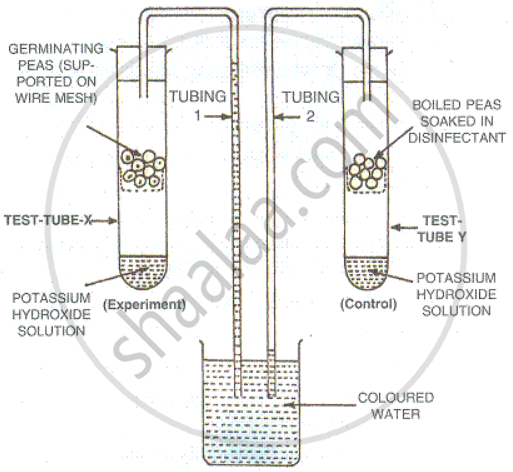
Why has the coloured water risen in tubing 1?
The following diagram refers to an apparatus which is used to demonstrate a physiological process:
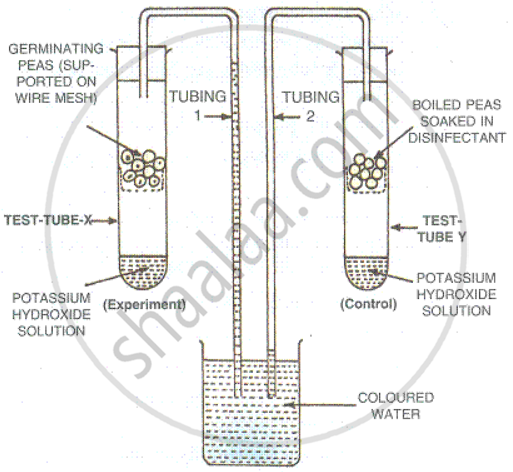
What is the purpose of keeping boiled peas soaked in a disinfectant in test tube Y?
The following diagram refers to an apparatus which is used to demonstrate a physiological process:

Name the biological process which causes the above rise.
The following diagram refers to an apparatus which is used to demonstrate a physiological process:
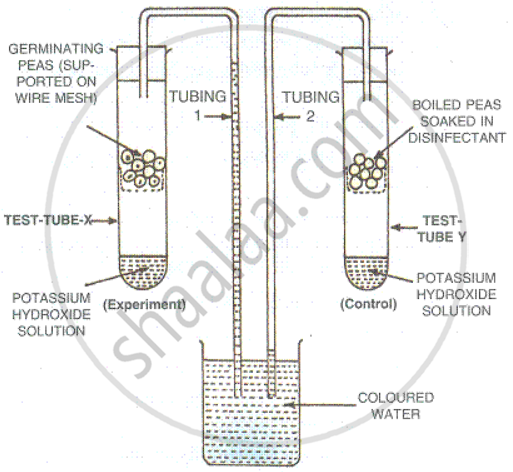
Define the biological process shown in the experiment.
Given below is a set of six experimental set-ups (A-F), kept in this state for about 24 hours.

In how many flasks, the different plant parts have been kept under observation?
Given below is a set of six experimental set-ups (A-F), kept in this state for about 24 hours.
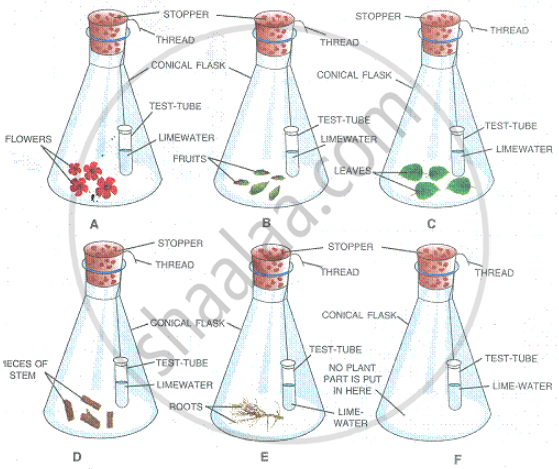
What is the purpose of keeping a test-tube containing limewater in each flask?
Given below is a set of six experimental set-ups (A-F), kept in this state for about 24 hours.
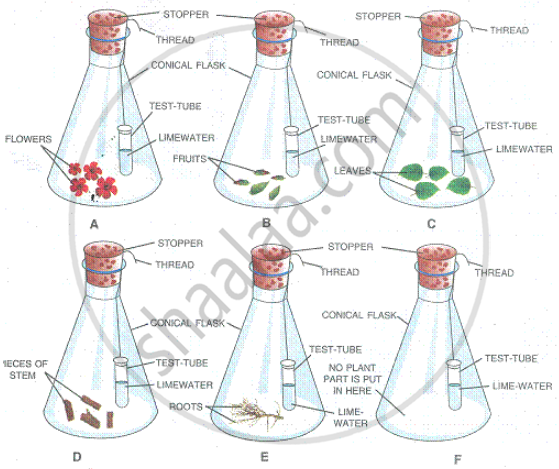
In which tube/tubes the limewater will turn milky?
Given below is a set of six experimental set-ups (A-F), kept in this state for about 24 hours.
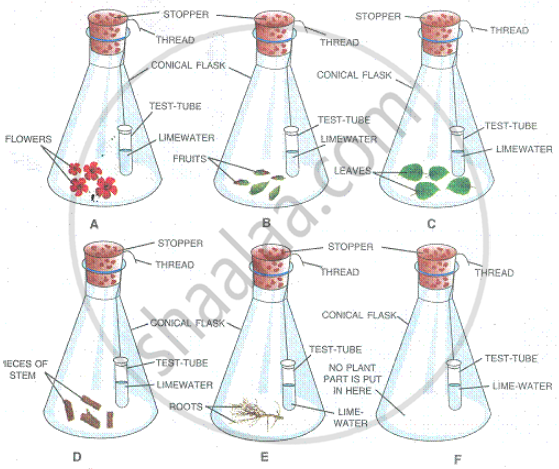
What is the purpose of the set-up F?
Given below is a set of six experimental set-ups (A-F), kept in this state for about 24 hours.
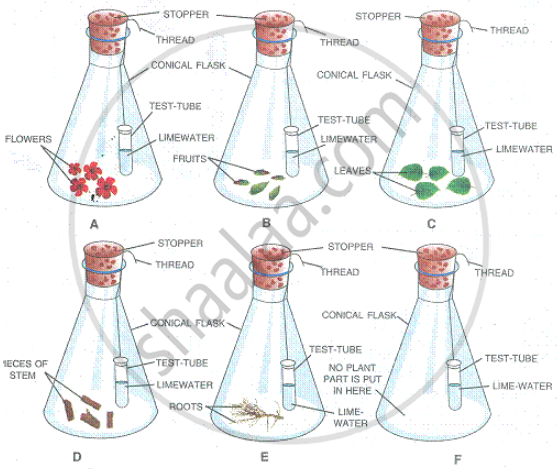
What conclusion can you draw from this experiment?
In order to study and prove a particular physiological process in plants, the following experiment was set up. Study the same and then answer the question that follows:
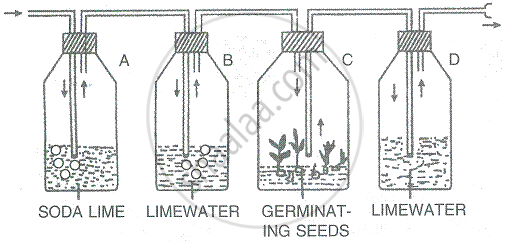
Name the physiological process being studied.
In order to study and prove a particular physiological process in plants, the following experiment was set up. Study the same and then answer the question that follows:

What is the function of soda lime in the bottle 'A' and why is limewater placed in bottle 'B'?
In order to study and prove a particular physiological process in plants, the following experiment was set up. Study the same and then answer the question that follow:

What change would you expect to observe in bottle 'D'?
In order to study and prove a particular physiological process in plants, the following experiment was set up. Study the same and then answer the question that follow:
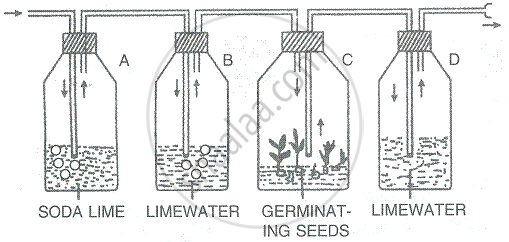
Represent the physiological process named in question 4.1 in the form of a chemical equation.
In order to study and prove a particular physiological process in plants, the following experiment was set up. Study the same and then answer the question that follow:
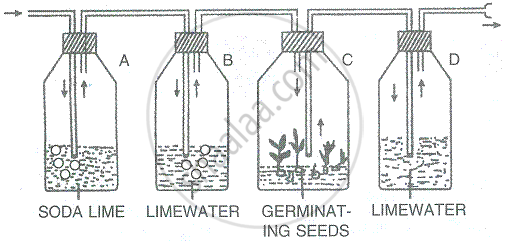
In order to obtain accurate results, the bottle 'C' should be covered with black cloth. Why?
In order to study and prove a particular physiological process in plants, the following experiment was set up. Study the same and then answer the question that follow:

If bottle 'C' was fitted with a 3-holed rubber stopper and a thermometer was introduced in such a way that its bulb reaches close to the germinating seeds, what would you observe? Why?
Solutions for 7: Respiration in Plants
![Selina solutions for Concise Biology [English] Class 9 ICSE chapter 7 - Respiration in Plants Selina solutions for Concise Biology [English] Class 9 ICSE chapter 7 - Respiration in Plants - Shaalaa.com](/images/4567167791-concise-biology-english-class-9-icse_6:778c9d06bf3248a296d8ab25ff5c174b.jpg)
Selina solutions for Concise Biology [English] Class 9 ICSE chapter 7 - Respiration in Plants
Shaalaa.com has the CISCE Mathematics Concise Biology [English] Class 9 ICSE CISCE solutions in a manner that help students grasp basic concepts better and faster. The detailed, step-by-step solutions will help you understand the concepts better and clarify any confusion. Selina solutions for Mathematics Concise Biology [English] Class 9 ICSE CISCE 7 (Respiration in Plants) include all questions with answers and detailed explanations. This will clear students' doubts about questions and improve their application skills while preparing for board exams.
Further, we at Shaalaa.com provide such solutions so students can prepare for written exams. Selina textbook solutions can be a core help for self-study and provide excellent self-help guidance for students.
Concepts covered in Concise Biology [English] Class 9 ICSE chapter 7 Respiration in Plants are Respiration Vs. Burning (Combustion), Types of Respiration: Aerobic and Anaerobic Respiration, Experiments on Respiration in Plants, Respiration and Photosynthesis, Organs of Respiratory Exchange, Respiration in Plant, Respiration, Phases of Respiration: Glycolysis, Phases of Respiration: Electron Transport System (Ets) and Oxidative Phosphorylation, Phases of Respiration: Tricarboxylic Acid Cycle (Citric Acid Cycle Or Kreb’s Cycle), Phases of Respiration: Pyruvate Oxidation (Link Reaction), Phases of Respiration: Fermentation, Formation of ATP.
Using Selina Concise Biology [English] Class 9 ICSE solutions Respiration in Plants exercise by students is an easy way to prepare for the exams, as they involve solutions arranged chapter-wise and also page-wise. The questions involved in Selina Solutions are essential questions that can be asked in the final exam. Maximum CISCE Concise Biology [English] Class 9 ICSE students prefer Selina Textbook Solutions to score more in exams.
Get the free view of Chapter 7, Respiration in Plants Concise Biology [English] Class 9 ICSE additional questions for Mathematics Concise Biology [English] Class 9 ICSE CISCE, and you can use Shaalaa.com to keep it handy for your exam preparation.
